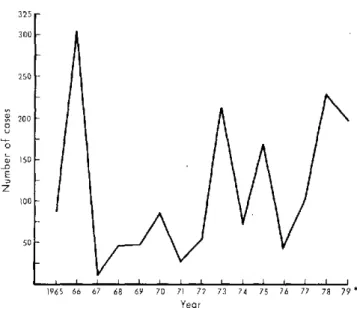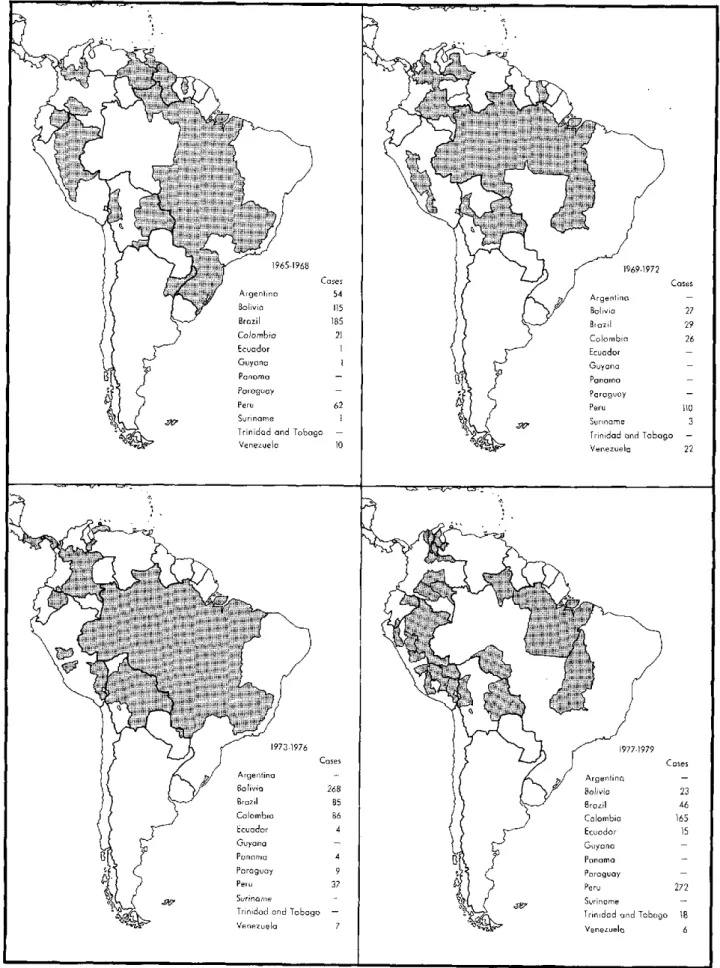e
Yellow Fever in the Americas
In the period 1965-1979 the average annual number of cases of jungle yellow fever in t.:e Americas, as reported to the Pan American Sanitary Bureau, was 114. Between 1967 and 1971 the countries reported less cases than the average, as shown in Figure 1.
Since 1972, incidence of the disease has shown an upward trend, occurring in two- or three-year cycles and gradually affecting areas in which no cases had previously been reported. The annual transmission cycle (according to data for 1975-1978) usually began in December-January, reached its peak in April-July, and declined to its lowest level in September-November.
rIn 1979 seven countries-Bolivia, Brazil, Colombia, Ecuador, Peru, Trinidad and Tobago, and Venezuela-reported cases of jungle yellow fever. This is the highest number of reporting countries in 15 years (see Table 1) and points to an increase in the disease in the Region. As of year-end 1979 a total of 205 cases had been registerejd (provisional figures) (Fig. 2).
Trinidad and Tobago reported 18 cases of jungle yellow fever. The first eight occurred between 27 December 1978 and 6 March 1979. Two of the eight patients died, the
first from yellow fever and the second from a bacterial infection accompanied by mneningitis and liver abscesses. Of interest is the fact that, according to the information available, this last-mentioned patient had not been in jungle areas. In studying the outbreaks and for the pur-pose of isolating the virus, successful use was made of AP-61 cell cultures (Aedes pseudoscutellaris). Between August and December 1979, 10 more cases of jungle yellow fever were reported. Following confirmation of the initial cases, about 85 per cent of the population was vaccinated against the disease.
In Colombia, an epidemic broke out in mid-1978, in the Tarra region in rural areas adjacent to forests; 28 deaths, due to jungle yellow fever, were reported, 13 of which were confirmed. Some of the patients were trans-ferred for treatment to nearby urban communities that were infested by A. aegypti, where they subsequently died; no cases of the disease transmitted by that mosquito were confirmed, however. In 1979 Colombia reported 51 cases of jungle yellow fever in the Departments of Cesar (13), Magdalena (30), Meta (6), and Santander (2).
No data are available on the number of inhabitants
Figure 1. Reported cases of jungle yellow fever in the Ameri-cas, 1965-1979.*
32 5r 300
-250 1
200
-o
u
-o E z
150so
1001
50
1965 66 67 68 69 70 71 72 73 74 75 76 77 78 79 * Year
*Up to 31 December 1979 (provisional data). '
2
.
*-~~·-)"1
0Figure 2. Reported cases of jungle yellow fever by major political division of each country, 1965-1979.*
Shaded areas indicate political divisions that reported cases of jungle yellow fever.
Table 1. Reported cases of jungle yellow fever, 1965-1979,* by country.
1965 1966 1967 1968 1969 1970
2 19 14 2 45 51 69 167 3 9 1 2 5 1 3 27 2 11 1 5 1 8 4 7 28 1 2 2 7 75
0
1971 1972 1973 1974 1975 1976 1977 1978 1979
8 9 86 12 151 19 2 11 10
11 12 70 13 1 1 9 27 12
9 3 16 36 12 22 9 105 51
- - - - 3 1 - 1 14
7 33 - 4 2 82 93 97
- 7 33 2 1 1 82 93 97
- 2 - - . . . . _
... _ . . .18. .í..
5 5 - - - 22 7 - - - - 3 3
87 304 12 47 48 86 28 55 212 76 168 44 102 240 205
*Up to 31 December 1979 (provisional figures).
- None.
exposed to jungle yellow fever or on the number of those vaccinated against the disease in the various countries. Even though information from throughout the Region is incomplete, coverage in urban areas of Trinidad and Tobago, Venezuela, and some Colombian cities is be-lieved to have been substantial.
Aedes aegypti infestation continues to be widespread in the Americas and affects many urban communities in the Hemisphere, especially in Colombia, El Salvador, Guatemala, Honduras, Mexico, Nicaragua, the United States of America, and Venezuela, as well as numerous Caribbean islands.
Recent studies made in Colombia appear to suggest that changes are taking place in the habits of vectors traditionally considered selvatic.
In view of this situation, PAHO held a meeting of ex-perts in yellow fever in Washington, D.C., in July 1979. The group concluded that, although the annual vaccine production in Latin America was 8 million doses-6 mil-lion prepared in the Oswaldo Cruz Foundation in Rio de Janeiro and 2 million in the National Institute of Health in Bogotá-the current stock was low (2.1 million doses in Rio de Janeiro and 400,000 doses in Bogotá) and in-sufficient to meet the demand in the event of an urban epidemic. The group recommended that 5-10 million doses should be available at all times.
The surveillance systems at present in use should be reviewed, in the opinion of the experts, who recom-mended that only persons exposed to risk be vaccinated. Although there is no evidence of a teratogenic effect of the 17D chick embryvaccine, pregnant women should only be vaccinated if expbsure to risk warrants it.
Laboratory confirmation is obtaúIed by isolation of the virus or by serologic tests. For virus isolation the group recommended the use of AP-61 cell culture and mice.
Attention was drawn to a number of aspects of re-search-some well known, others more recent-which
should be taken into account in the Americas. These in-clude studies of competition between various A. aegypti vector strains in transmitting yellow fever virus; genetic and transovarial transmission of yellow fever in Aedes mosquitoes; use of insect cell lines in cases in which mice cannot be used for isolation of the virus, in diagnosing yellow fever, and possibly as a substrate for production of vaccine; and duration of antibodies in persons vacci-nated.
Other new and promising aspects of research include use of the enzyme-linked immunosorbent assay (ELISA) test for serodiagnosis, development of radioimmuno-assay and immunoradioimmuno-assay tests in thin layers for detection of antigens, use of hybridomes for producing specific antibodies in vitro, and studies on interferon in antiviral drugs in clinical treatment of the disease.
Other tests that should be compared with those cur-rently in use include tests for plaque-reduction neutrali-zation, fluorescent foci-inhibition neutralineutrali-zation, and histopathology of the liver.
Finally, the group recommended that a seminar on yellow fever be held in the Americas in 1980 for admin-istrators, epidemiologists, vector control specialists, ecologists, laboratory research workers, and vaccine specialists. It should focus on the present status of the disease in the Americas; reevaluate the risks of its ur-banization; recommend measures necessary for prevent-ing and controllprevent-ing jungle and urban yellow fever; foster innovative research aimed at effecting positive changes in prevention or control; and promote the exchange of information on new diagnostic techniques.
This meeting will be held in Belem, Brazil, 18-22 April 1980.
(Virology Program, Communicable Disease Control Unit, Division of Disease Prevention and Control, PAHO.)
4 Argentina Bolivia Brazil Colombia Ecuador Guyana Panama Paraguay Peru Suriname Trinidad and
Tobago Venezuela Total
Diseases Subject to the
International Health Regulations
Cases and deaths caused by cholera, yellow fever, and plague
reported in the Region of the Americas in 1979*
Country and Yellow Fever Country and Yellow Fever
administrative Cholera Plague administrative Cholera Plague
division cases Cases Deaths cases division cases Cases Deaths cases
Bolivia - 10 7 2 Peru - 97 87
La Paz - 8 6 2 Ayacucho - 5 5
Santa Cruz - 2 1 - Huánuco - 24 22
Junín - 34 31
Loreto - 2 -
-Brazil - 12 9 - Madre de Dios - 13 13
-Amazonas - 2 2 - Puno - 3 3
-Goiás - 3 2 - San Martín - 16 13
-Pará - 5 3
-Rondonia - 2 2 - Trinidad and Tobago - 18 7
-Trinidad - 18 7
-Colombia - 51 36 - United States I - - 10
Cesar - 13 13 - Arizona - - - 3
Magdalena - 30 15 - California 1 - -
-Meta - 6 6 - Colorado - - - 2
Santander - 2 2 - Nevada - - - 1
New Mexico - - - 4
Ecuador - 14 13 - Venezuela - 3 2
-Napo - 1 - Mérida - 1 1
-Zamora/Chinchipe - 13 13 - Zulia - 2 1
-*Provisional data. -None. ... Data not available.
Smallpox Ei
r
The Global Commission for the Certification of Small-pox Eradication reached the following conclusions in the report of its final meeting in December 1979:1. Smallpox eradication has been achieved through-out the world.
2. There are no reasons for fearing the reappearance of smallpox as an endemic diseasej
* The report also pointed out that more than two years had elapsed since the discovery of the last case of
en-radication
,D
demic smallpox in Somalia in October 1977. It added that neither the special surveillance activities undertaken in the last endemic countries nor the investigation of pre-sumed cases and rumors elsewhere in the world had de-tected a single case of endemic smallpox since that time.
The Global Commission was an independent body of experts established by the Director-General of WHO in 1978, at the request of the Executive Board of the Orga-nization, for the purpose of evaluating the extent of smallpox eradication throughout the world.


